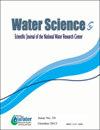Spatiotemporal analysis of water reservoirs in San Luis Potosí state, Mexico, from 1990 to 2015
Q2 Environmental Science
引用次数: 0
Abstract
It is essential to identify the spatial distribution and use of water resources for developing appropriate strategies for their use. Therefore, this work aimed to estimate the spatial distribution of economic and ecological Water Use Profit (WUP) and relate it to the Normalized Differential Water Index (NDWI) and evapotranspiration in the San Luis Potosí state, México. When calculating or obtaining the NDWI, this indicator is associated with values of evapotranspiration concentrations that are obtained spatially in the various portions of the territory, since in SLP territory the climate and soil moisture vary from one region to another, as there are 4 different regions. The methodology in this study involved a multitemporal analysis of the WUP in the State corresponding to 1990, 2000, 2010, and 2015, since it is an indicator that measures the uses and water exploitation in a region obtained over time, which is why it is called multitemporal, since we are talking about a 25-year period of analysis and the result is different from one place to another in San Luis Potosi territory. This study was realized through the application of economic and ecological indicators which were evaluated, considering the economic and ecological activities that use water in the region; therefore, the behavior of ETR depends on the area and the economic and/or ecological activities that have been carried out in the period. Also, for understanding the behavior of water reservoirs in the basins in the study area, the NDWI was obtained from Landsat 8 imagery. The results of NDWI showed that, from 1990 to 2015, there was a decrease in moisture content, becoming more evident in 2000. This study found that secondary and tertiary activities significantly influence yearly economic value. From 1990 to 2000, the Gross Domestic Product (GDP) value doubled, while from 2000 to 2010 tripled, and for 2015 the increase was nearly 25% compared to 2010. The WUPeconomic’s and WUPecological’s highest values were obtained in the most important urban areas of the state because secondary and tertiary activities are mainly developed. It is precisely with this reasoning that the behavior of relationship between ETR and WUP is vital for the understanding of water consumption generated. Finally, the ETR’s highest values are in the Huasteca region of the state.1990 - 2015年墨西哥圣路易斯市Potosí水库时空分析
必须确定水资源的空间分布和利用情况,以便制定适当的利用战略。因此,本研究旨在估算圣路易斯Potosí州经济和生态用水利润(WUP)的空间分布,并将其与归一化差异水指数(NDWI)和蒸散量联系起来。在计算或获得NDWI时,该指标与领土各部分的空间蒸散浓度值相关联,因为在SLP领土上,气候和土壤湿度因区域而异,因为有4个不同的区域。本研究的方法涉及对该州1990年、2000年、2010年和2015年的WUP进行多时段分析,因为它是衡量一个地区随时间推移的使用和水资源开发的指标,这就是为什么它被称为多时段的原因,因为我们谈论的是一个25年的分析周期,结果在圣路易斯波托西地区各地不同。本研究是通过应用经济和生态指标进行评价来实现的,考虑了该地区的经济和生态用水活动;因此,ETR的行为取决于该时期所进行的地区和经济及/或生态活动。此外,为了了解研究区盆地的水库行为,利用Landsat 8图像获得了NDWI。NDWI结果显示,1990 - 2015年,流域含水率呈下降趋势,2000年下降趋势更为明显。研究发现,二级和三级活动对年经济价值有显著影响。从1990年到2000年,国内生产总值(GDP)价值翻了一番,从2000年到2010年增长了两倍,2015年与2010年相比增长了近25%。WUPeconomic和WUPecological的最大值出现在国家最重要的城市地区,因为二级和三级活动主要发展。正是基于这一推理,ETR与WUP之间的关系行为对于理解产生的用水量至关重要。最后,ETR的最高值出现在该州的Huasteca地区。
本文章由计算机程序翻译,如有差异,请以英文原文为准。
求助全文
约1分钟内获得全文
求助全文

 求助内容:
求助内容: 应助结果提醒方式:
应助结果提醒方式:


